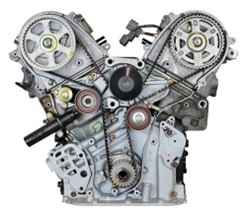Posted on 2/28/2023

All four stroke Otto cycle engines use some kind of timing belt (Black toothed belt in the picture), chain, or gears to keep all of the moving parts inside the engine in alignment and moving in the correct order. Each cylinder in an engine has four distinct events that complete one power cycle; intake, compression, power, and exhaust strokes. The piston goes up and down two times per one power cycle. Valve openings and closings must be timed to the piston position and are controlled by camshaft rotation (Large gears on the top are attached to the camshafts). While the piston osolations are controlled by crankshaft rotation (Small gear on the bottom is on the front of the crankshaft). The crankshaft makes two complete revolutions for each single revolution of the camshaft. These components must work in concert with each other for the engine to run smoothly and efficiently. If this alignment gets out of sync it can cause numerous problems. ... read more
Posted on 2/1/2023

The four-wheel drives and when to use them. Maybe you have always owned four-wheel drive trucks? Maybe this is your first four-wheel drive vehicle? Four-wheel drive gives the driver options. Knowing how to best use those options is the key to success. Does four-wheel drive allow you to get through anything? Not even remotely close! Sometimes it just allows you to get more stuck and broken. To understand how to best use your four-wheel drive options we need to go over a few basic principles. First, the drive axle differential. All vehicles use a differential on the drive axle to allow for smooth turns. When a vehicle goes around a corner the outside tire needs to cover more ground than the inside tire. Power from the engine/transmission comes into the center differential and is distributed to the drive tires via the drive axles. The differential allows for the difference in wheel speeds while provid ... read more